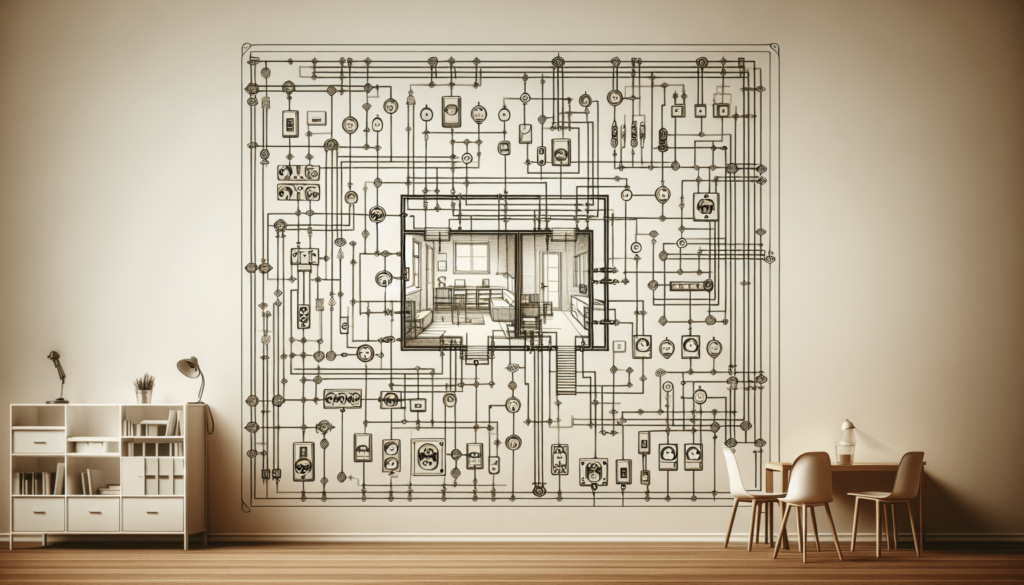

Have you ever wondered how the electrical system in your home actually works? Understanding your home’s electrical wiring can seem daunting at first, but grasping the basics can help you manage your household’s power with confidence. In this guide, you’ll learn about electrical diagrams for house wiring, empowering you to connect lights, outlets, and appliances safely and efficiently.
What is an Electrical Diagram?
An electrical diagram is a visual representation of an electrical system. It outlines the connections between various components, helping you understand how electricity flows through your home. Electrical diagrams can seem complex, but breaking them down into more manageable parts can make them much easier to interpret.
Types of Electrical Diagrams
There are various types of electrical diagrams that serve different purposes. Here are a few that are commonly used in residential wiring:
- Wiring Diagrams: These show the actual connections in an electrical system, highlighting the components used and how they connect.
- Schematic Diagrams: These focus more on the functional relationships between components rather than the physical layout.
- Single-Line Diagrams: These simplify a complex system to a single line to represent an entire system’s electrical flow, commonly used in larger or more complex installations.
By knowing these types, you can choose the right diagram based on your needs.
The Importance of Electrical Diagrams
Having an electrical diagram is crucial for several reasons. It not only helps in the installation process but also plays a significant role in troubleshooting any electrical issues that might arise later. Here’s why having a good diagram handy is essential for every homeowner:
-
Safety: Understanding the layout helps you avoid potential dangers, such as electrical shocks or short circuits.
-
Efficiency: A well-laid-out diagram makes it easier to plan your electrical system, ensuring it meets your needs without wasting energy.
-
Maintenance: When you know where everything is connected, tackling repairs and upgrades becomes a lot simpler.
Basic Components of Electrical Wiring
Before diving into diagrams, it’s essential to learn about the primary components involved in house wiring. Here are some key elements:
-
Circuit Breaker:
- Protects the electrical circuit from overload.
- Automatically shuts off electrical flow when excessive current is detected.
-
Wires:
- Carry electrical current throughout your home.
- Different wire types (like THHN, Romex) are suitable for specific applications.
-
Outlets and Switches:
- Outlets allow you to plug in devices, while switches control the flow of electricity to lights and appliances.
-
Electrical Panel:
- Distributes electricity from the utility provider to different circuits in your home.
Understanding these components will help you interpret an electrical diagram more effectively.
Understanding the Electrical Circuit
An electrical circuit is a closed loop that allows electricity to flow. Here’s a breakdown of how circuits work:
- Current Source: Usually provided by the utility company, this is where the electricity originates.
- Load: The devices that consume electricity, such as lights and appliances.
- Path: The wiring that carries electricity from the source to the load.
Take this simple illustration of a circuit:
| Component | Function |
|---|---|
| Power Source | Provides electricity |
| Load | Uses electricity (e.g., a light bulb) |
| Wiring | Connects everything together |
By understanding these components, you can better appreciate how power flows through your home.

How to Read an Electrical Diagram
Reading an electrical diagram may seem intimidating, but you can learn how to do it with a bit of practice. Here are some key symbols you’ll encounter:
- Wires: Represented by straight lines. Different line styles can indicate various wire types.
- Lights: Typically drawn as small circles or bulbs.
- Switches: Shown with a break in the line connecting a wire.
Familiarizing yourself with these symbols can significantly enhance your ability to understand electrical diagrams.
Example of a Simple Electrical Diagram
To illustrate how wiring diagrams look, let’s look at a simple example of a light fixture connected to a switch.
[Power Source] —- [Switch] —- [Light Fixture]
This diagram shows a basic circuit where electricity flows from the source to the switch, allowing you to turn on the light fixture. Breaking it down into segments makes it easier to understand.
Basic House Wiring Layout
A typical house wiring layout includes circuits for lighting, outlets, and specialized appliances like refrigerators or HVAC systems. Understanding these layouts helps manage the electrical requirements properly.
The Primary Circuits in a Home
Here’s a brief overview of the most common circuits in a house:
| Circuit Type | Typical Use |
|---|---|
| Lighting Circuit | Powers lights throughout the house |
| General Purpose Circuit | Powers outlets in living areas and bedrooms |
| Appliance Circuit | Dedicated circuits for heavy appliances like microwaves |
| HVAC Circuit | Powers heating and air conditioning systems |
Each circuit serves a unique purpose, and understanding these distinctions can help you troubleshoot issues and plan your installation effectively.

Creating Your Own Electrical Diagram
Drawing your electrical diagram can be a rewarding experience. With a simple approach, you can create a layout effectively by following these steps:
- Determine Your Needs: Identify the areas where you want to install lighting or outlets.
- Sketch the Layout: Use a floor plan to mark where you want each component.
- Select Components: Choose the switches, outlets, and fixtures you plan to use.
- Draw Connections: Indicate how everything connects together.
Tools You’ll Need
To create your diagram, you may want a few tools:
- Graph Paper: For drawing with precision.
- Pencil and Eraser: Easy to adjust as your plan changes.
- Ruler: Helps create straight lines for clarity.
Being organized and precise is key to a successful diagram.

Common Electrical Wiring Mistakes to Avoid
While working on house wiring, there are several common mistakes you’ll want to avoid:
- Overloading Circuits: Plugging too many devices into one outlet can create a fire hazard.
- Using Wrong Wire Types: Each wire type is rated for specific uses; using the wrong one can risk safety.
- Neglecting Grounding: Grounding your electrical system is crucial to prevent shocks.
By keeping these points in mind, you can keep your project safe and efficient.
Local Building Codes and Regulations
Before undertaking any electrical project, be sure to check your local building codes and regulations. These laws are designed to keep you and your home safe. Here’s what to consider:
- Permits: Some projects may require applications for permits.
- Inspections: After installation, you might need inspections to ensure compliance with safety standards.
Checking these requirements will save you time, money, and stress in the long run.
Finding Information on Local Codes
You can usually find local building codes through:
- Your city or county’s building department website.
- Local electrical contractors who are familiar with regulations.
- Community workshops that might discuss safe practices in housing electrical systems.
The more informed you are, the more confident you’ll feel when working with electrical wiring.
Safety Guidelines for Electrical Work
Safety should always be your top priority when dealing with house wiring. Here are essential guidelines to follow:
- Turn Off Power: Always switch off the power at the circuit breaker before working on electrical systems.
- Use Appropriate Tools: Employ insulated tools for electrical work to minimize shock risk.
- Work in Dry Areas: Water and electricity do not mix. Make sure your workspace is dry.
By adhering to these safety tips, you can enjoy peace of mind while working on your home’s electrical system.
Emergency Preparedness
Despite taking all the precautions, accidents can happen. Be prepared by:
- Having a Fire Extinguisher Handy: Ensure it’s rated for electrical fires.
- Knowing Your Nearest Exit: Creating a clear escape route is crucial.
- Having an Emergency Contact List: Keep contacts for local electricians or emergency services easily accessible.
Being prepared can make all the difference in handling unexpected situations.
Tools Needed for House Wiring Projects
If you plan to work on your own electrical projects, having the right tools is crucial. Here’s a list of essential tools you’ll likely need:
- Multimeter: For measuring voltage, current, and resistance.
- Wire Strippers: Useful for stripping insulation off wires.
- Screwdrivers: Both flat-head and Phillips for securing components.
- Fish Tape: Helps pull wires through walls easily.
- Cable Cutters: To cut through various types of wires neatly.
Investing in quality tools will help make your job smoother and more effective.
Wiring Tips for Beginners
If you’re new to electrical wiring, here are some tips to get you started on the right foot:
- Read Local Codes: Understand your local electrical codes to ensure compliance.
- Start Small: Begin with simple tasks, such as replacing light fixtures, before taking on larger projects.
- Seek Help: Don’t hesitate to ask for assistance from experienced friends or professionals if you feel uncertain.
This approach will help build confidence and expand your knowledge over time, making your future projects more manageable.
Understanding Voltage and Amperage
Two critical concepts in electrical systems are voltage and amperage. Here’s a quick rundown on these terms:
- Voltage (V): This represents the potential energy in the system, or how much force pushes electric current through a circuit.
- Amperage (A): This measures the flow of electric current. It essentially indicates how much electricity is flowing through a circuit over time.
Understanding these concepts will allow you to assess your home’s electrical needs better.
| Parameter | Description |
|---|---|
| Voltage | The potential energy of the electrical system |
| Amperage | The flow rate of electric current in the system |
Being familiar with these concepts will help you make informed decisions regarding your electrical system.
Conclusion
With this guide, you now have a comprehensive understanding of electrical diagrams for house wiring. You’ve learned about different types of diagrams, the importance of knowing your components, and how to create your own layout. Plus, you’re aware of the tools and safety measures necessary for any wiring project.
Whether you plan to undertake DIY projects or simply want to understand how your home’s electrical system operates, this knowledge lays a solid foundation. Always remember: safety first, keep learning, and don’t hesitate to ask for help when you need it! Happy wiring!






